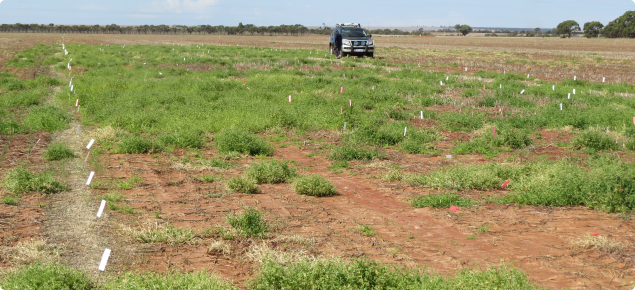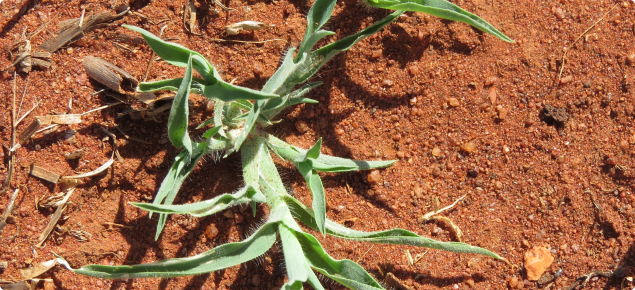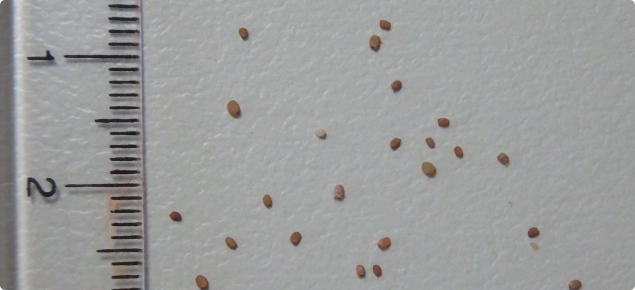Identification and attributes
Button grass is also known as finger grass. It is a summer annual or ephemeral species (that is, a species with a short life cycle, surviving as long as summer moisture is available). It grows semi erect, with spreading branches forming leafy tufts. A single plant can form up to 45 primary tillers. The tiller stems are up to 40cm long, slender, smooth and hairless, and often bend at the nodes. This species has grass-like leaves with tapering sides and pointed tips. The leaf blade is approximately 80mm long and 2-6mm wide at the base, tapering to a point. The leaves are flat, and may be covered in hairs. The edges of the leaf are often wrinkled or fringed, with long (1.5-2mm) hairs. A single plant has both prostrate and erect tillers. The prostrate tillers develop roots at the node, and branch into 7-8 secondary tillers. This allows a single plant to spread over an area of 1.5m diameter.
The plant develops 2-3 seed heads on the end of each tiller. Each seed head has 3-11 compact spikes in a finger-like arrangement. The individual spikes are 5-13mm long. Each spike contains overlapping spikelets, which contain 5-11 seeds per spikelet (approximately 8000 seeds/plant or 32 000 seeds/m2). Entire spikes (with the spikelets attached) are shed from the plant to disperse the seeds. The seeds are less than 1mm long, and closely resemble brown grains of sand.
Biology
Button grass seeds have initial dormancy (after-ripening requirements) and a requirement for light to stimulate germination. Seeds on the soil surface in Merredin, Western Australia increased germination from 0% in the first month to 40% germination in the second month. However, germination of seed buried at 2cm remained low over 6 months. Germination is increased to approximately 90% by scarification (breaking the seed coat). It is clear that seed germination is higher when seeds are on the soil surface, exposed to light and with an opportunity to degrade the seed coat.
This species thrives in open areas (especially pasture or zero tillage systems), seasonal swamps and river banks. Exposure of seeds to water for 10 days increases germination, although 30 days of water reduced germination to less than 10%. This confirms the tendency of button grass to germinate rapidly after heavy rainfall and favour environments like river banks that might be subject to temporary flooding. Button grass can tolerate a wide range of climates and soil types (including saline and swampy soils), but is most common on sandy and loamy soils.
Why is it a weed?
Button grass is a very common species over the summer/autumn fallow in Western Australia. Like most summer grass weeds it depletes soil moisture and nutrients, reducing the yield potential of the subsequent crop. Summer weeds also act as a green bridge for crop pests and disease. The rapid emergence and growth of button grass after rainfall makes it important for the Australian plague locust. It can be a valuable pasture species in arid areas, although overgrazing of button grass (green or dry plants) in stockyards can result in nitrate-nitrite toxicity in sheep and cattle. Further, toxicity from prussic acid can result in the field when hungry stock are exposed to lush growth. However, dry plants are rarely toxic in the field. Button grass is difficult to control, as the stressed, dusty plants are poorly responsive to herbicides. Button grass is often the first species to germinate in summer, but it is also the first species to experience heat or moisture stress. Therefore, it is important to spray herbicides before the plants become stressed.
Herbicide resistance
There is no evidence of herbicide resistance in button grass. However, glyphosate is commonly overused and button grass is at high risk of developing resistance to this product.
Tactics for integrated weed management
Button grass is a widespread weed in Australia and is favoured by no tillage farming systems as a result of greater germination of seeds on the soil surface. This weed can be effectively managed with an integrated weed management (IWM) plan.
Knockdown control
Like most summer weeds, dusty, moisture stressed button grass plants at the height of summer are difficult to control. Button grass is one of the first summer weed species to emerge, but it is also one of the first species to become moisture stressed, making older plants poorly responsive to herbicides. In very hot conditions, high rates of glyphosate alone or glyphosate followed by Para-Trooper® in a double knockdown treatment give excellent control of plants at all growth stages. Large rate responses are seen with glyphosate products (either alone or in a tank-mix/double knockdown treatment) and this herbicide is more effective against button grass in cooler autumn weather. However, to avoid resistance development, glyphosate should be used at high rates. Paraquat or paraquat + diquat products give poor control when applied alone, even at high rates. Button grass plants are initially affected by these herbicides but re-sprout after 2-3 weeks. However, paraquat is effective when used in a double knockdown treatment.
Residual control
Imazapic herbicide (for example, Flame®) is registered for button grass control in fallow, sugar cane and peanuts. Stomp® is registered for residual control in grain crops (wheat, barley, canola, chickpea, field pea, lentil, lupin).
Grazing
Graze infested areas heavily and continuously during spring, summer and autumn. However, it is necessary to manage toxicity risks by ensuring that stock have an alternative food source and are not in poor condition when first exposed to paddocks with a high density of button grass.
Burning residue
Button grass seeds are small, with a thin seed coat. Therefore, they are easy to destroy by burning, but sufficient crop residues are needed to achieve a uniform burn.
Cultivation
Strategic cultivation (for example, mouldboard ploughing) to bury seed is highly effective, as the seeds cannot germinate from depth. However, buried seed may remain dormant, so it is important to ensure buried seeds are not immediately returned to the surface in subsequent years.





